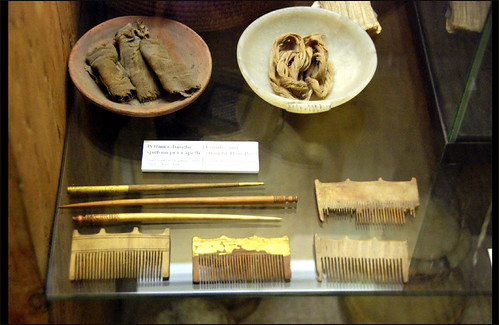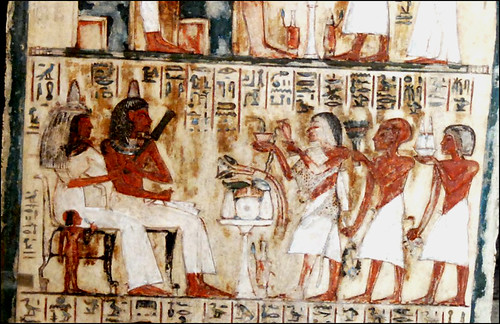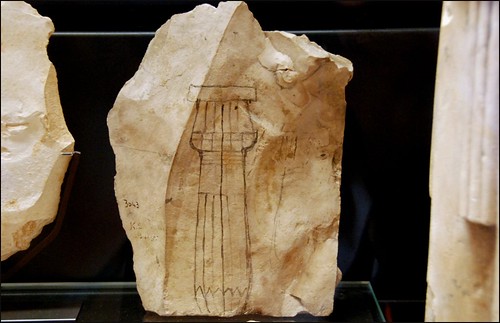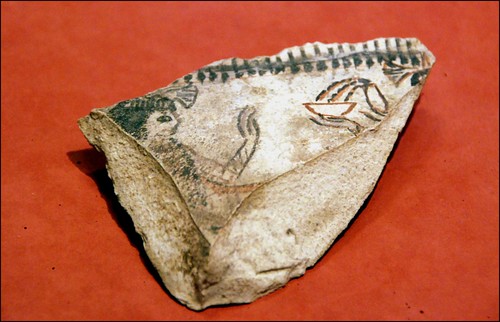Sehetepibra
De Wikipedia, la enciclopedia libre
Sehetepibra Hornedyheritef sa Kemau, o Sehetepibra II "quien satisface el corazón de Ra", fue un faraón de la dinastía XIII de Egipto. Reinó unos dos años, c. de 1738 a. C. (Krauss, Franke).
Aparece mencionado como Sehetepibra en el Canon Real de Turín, en el registro VI,12.
Este gobernante fue posiblemente de origen asiático, pues su nombre, Hornedyheritef sa Kemau, significa "Horus protege a su padre, hijo del asiático".
Es posible que se trate del mismo faraón que Hetepibra y que la inscripción que carece del signo inicial S sea un error (Kim Ryholt).
Amenemhat I también llevaba el nombre de Trono de Sehetepibra, por lo que a veces, a este faraón, se le denomina Sehetepibra II.
Testimonios de su época [editar]
Sólo quedan algunos restos de su palacio en Tell el-Daba.
A este rey se le atribuye también un escarabeo encontrado en Jericó.
Titulatura [editar]
| Titulatura | Jeroglífico | Transliteración (transcripción) - traducción - (procedencia) |
| Nombre de Nesut-Bity: |
| s ḥtp ib rˁ (Sehetepibra) Satisfecho está el corazón de Ra (Canon Real de Turín nº 6,12) |
| Nombre de Sa-Ra: |
| s3 qm3u ḥr nḏ ḥr it.f (Hornedyeheritef sa Kemau) Horus protege a su padre, hijo del asiático (Annales du Service des Antiquités nº 52,9) |
Enlaces externos [editar]
| Predecesor: Semenkara | Faraón Dinastía XIII | Sucesor: Suadyekara |
En otros idiomas
| |
Galeria de Hans Ollermann
Deir el-Medina.
2008_0610_164358AA Egyptian Museum, Turin

Combs and straight hair pins.
From the Tomb of Kha (TT8), Deir el-Medina.
Dynasty XVIII, Reign of Amenhotep II, Tuthmose IV, & Amenhotep III.
(text Su, London)
Tomb of Kha and his wife Merit.
Kha was architect of the Pharaoh (Amenhotep II 18th Dynasty) and responsible for building projects not just in the reign of Amenhotep II, but also in the reign of 3 or 4 kings: Tuthmosis III, Amenhotep II, Tuthmosis IV and Amenhotep III
The intact tomb was discovered by E. Schiaparelli in 1906.
The access shaft to the funerary chamber was neither located in the chapel nor in the courtyard, but at a certain distance from both.
The collapse of a nearby Ramesside tomb had hidden it completely, thus preserving the burial intact through the course of 33 centuries.
A staircase led to a corridor and ante-chamber.
The funerary provisions were placed here because there was no room in the burial chamber itself at the time of the burial.
A bed, two baskets, two amphora's and a chair were also in this ante-chamber.
The entrance to the funeral chamber was blocked by a heavy wooden door that was closed on the in-side.
The chamber itself was rectangular with smooth plastered walls.
The great rectangular sarcophagi were inside, placed along the walls and covered with linen sheets.
A statue of Kha was on a chair, which stood in front of the sarcophagus of Merit.
It was garlanded with flowers.
Egyptian Museum, Turin.
Comentários
Lenka P  disse:
disse:
Oh Hans, I love the combs, I wanted to put these on the page but could not find the image. Fantastic! I myself use a wooden comb.... but I have only one and it has been glued together several times as it is quite impossible to find a new one. Postado 20 meses atrás. ( permalink )
2008_0610_164935AA Egyptian Museum, Turin

Stela from Tomb of Kha (TT8), Deir el-Medina.
Detail.
Dynasty XVIII, Reign of Amenhotep II, Tuthmose IV, & Amenhotep III.
(text Su, London)
Tomb of Kha and his wife Merit.
Kha was architect of the Pharaoh (Amenhotep II 18th Dynasty) and responsible for building projects not just in the reign of Amenhotep II, but also in the reign of 3 or 4 kings: Tuthmosis III, Amenhotep II, Tuthmosis IV and Amenhotep III
The intact tomb was discovered by E. Schiaparelli in 1906.
The access shaft to the funerary chamber was neither located in the chapel nor in the courtyard, but at a certain distance from both.
The collapse of a nearby Ramesside tomb had hidden it completely, thus preserving the burial intact through the course of 33 centuries.
A staircase led to a corridor and ante-chamber.
The funerary provisions were placed here because there was no room in the burial chamber itself at the time of the burial.
A bed, two baskets, two amphora's and a chair were also in this ante-chamber.
The entrance to the funeral chamber was blocked by a heavy wooden door that was closed on the in-side.
The chamber itself was rectangular with smooth plastered walls.
The great rectangular sarcophagi were inside, placed along the walls and covered with linen sheets.
A statue of Kha was on a chair, which stood in front of the sarcophagus of Merit.
It was garlanded with flowers.
Egyptian Museum, Turin.
2008_0610_161218AA Egyptian Museum, Turin

Swabti's of Kaemter.
Deir el-Medina.
Dynasty XVIII-XX (1550-1070 B.C.)
Egyptian Museum, Turin.
2008_1112_133022AA- Musée du Louvre, Paris.

Deux dessins d'une colonne.
19e-20e dynastie.
1295-1069 Av. J.-C.
Deir el-Medineh.
calcaire peint.
Ancient Egyptian ostraca in the Musée du Louvre, Paris.
Comentários
L'Angelo Misterioso disse:
Drawings of colums.Ramesside Period
Postado 15 meses atrás. ( permalink )
2008_1112_133015AA- Musée du Louvre, Paris.

Deux dessins d'une colonne.
19e-20e dynastie.
1295-1069 Av. J.-C.
Deir el-Medineh.
calcaire peint.
Ancient Egyptian ostraca in the Musée du Louvre, Paris.
Comentários
L'Angelo Misterioso disse:
Drawing of a column. Ramesside Period.E 14315
Postado 15 meses atrás. ( permalink )
2008_1112_131654AA- Musée du Louvre, Paris.

Une femme se fait servir à boire.
19e-20e dynastie.
1295-1069 Av. J.-C.
Village de Deir el-Medineh.
éclat de calcaire peint.
Ancient Egyptian ostraca in the Musée du Louvre, Paris.
Comentários
L'Angelo Misterioso disse:
This limestone chip is not immediately known to me.Ramesside Period
Postado 15 meses atrás. ( permalink )




![X1 [t] t](http://es.wikipedia.org/w/extensions/wikihiero/img/hiero_X1.png)
![Q3 [p] p](http://es.wikipedia.org/w/extensions/wikihiero/img/hiero_Q3.png)










